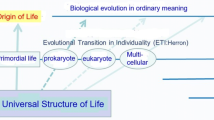Abstract
Shannon’s information quantity I(E) = log(1/P(E)) is defined under an assumption of the existence of a “cognitive subjective entity” capable of judging yes/no or occurred/not-occurred of an event E (which occurs with a probability P(E)). The final acceptor/user of information is a living individual, although first and/or intermediate sender(s) and/or acceptor(s) of information may be either living individual(s) or nonliving element(s) or man-made machine(s). Therefore we can conclude that information is a most essential character of living individuals, and that information and life must have emerged simultaneously as a “minimum cognitive system” (MCS). Since then, living individuals/lives must have evolved as “self-revising learning neural network machines” capable of “active evolution”. How MCS could have emerged was discussed.
Similar content being viewed by others
References
Albert B, et al (2008) Molecular biology of the cell, 5th edn. Garland Science, New York
Rowe GW (1994) Theoretical models in biology. Oxford University Press, Oxford
Ohnishi K, et al (2002) Neural-network-like bio-machinogenesis via semeiogenesis: a unified theory on the origin of genetic codes and other semeiotic systems. Viva Origino 30(2):63–78
Ohnishi K, Shutou H, Sawamura H, et al (2001) Neural-networklike machinogenesis via semeiogenesis: origins of genetic codes and other semeiotic systems. SIG Tech Rep 2001(37):3–6
Maynard-Smith J (1989) Evolutionary genetics. Oxford University Press, Oxford
Ohnishi K (1996) On the origin of diploidy and diploid species: homologous chromosome pairing as kinship-recognizing behaviour of unicellular haploid individuals. Origins Life Evol Biosphere 26:499–500
Dan-Sohkawa M (1996) Understanding the complexity of life. Biology of hierarchy (in Japanese). Heibon-sha, Tokyo
Hamilton WD (1964) The genetical evolution of social behaviour I, II. J Theor Biol 7:1–16;17–52
de Saussure F (1989) Cours de linguistique générale. Édition critique par Rudorf Engler. Tome 1. Harrassowitz, Wiesbaden
Ohnishi K (1993) Evolution from semi-tRNA to early proteinsynthesizing RNA molecules. In: Sato S, Ishida M, Ishikawa H (eds) Endocytobiology V. Tubingen University Press, Tubingen, pp 407–414
Ohnishi K, Hokari S, Shutou H, et al (2002) Origin of most primitive mRNAs and genetic codes via interactions between primitive tRNA ribozymes. Genome Informatics 13:71–81
Ohnishi K, Ohshima M, Furuichi N (2005) Evolution from possible primitive tRNA viroids to early poly-tRNA-derived mRNAs. Genome Informatics 16:94–103
Rumelhart DE, Hinton GE, Williams RJ (1986) Learning representations by back-propagating errors. Nature 323:533–536
Zobuchi Y, Li L (2006) Restriction of teacher signal in digital type BP learning algorithm (in Japanese). IEICE Tech Rep KBSE2006-43 (2006-11), pp 22–26
Dawkins R (1996) The blind watchmaker. Norton, New York
Mayr E (1942) Systematics and the origin of species. Columbia University Press, New York
Mayr E (1969) Principles of systematic zoology. McGraw-Hill, New York
Paterson HEH (1985) The recognition concept of species. In: Vrba ES (ed) Species and speciation. Transvaal Museum, Pretoria, Monograph No. 4, pp 21–29
Barabasi AZ, Oltvai ZN (2004) Network biology: understanding the cell’s functional organization. Nature Rev Genetics 5:101–113
Ohnishi K (2008) A preliminary consideration on the origin of life as a cognitive system. Proceedings of the 13th International Conference on Artificial Life and Robotics, Oita, pp 686–689
Ohnishi K (2009) Harmonic oscillations in Lotka-Vorterra dynamic systems: a new approach from a matrix operator equation system. Proceedings of the 13th International Conference on Artificial Life and Robotics, Oita, pp 271–276
Kauffman SA (1993) The origins of order. Self-organization and selection in evolution. Oxford University Press, New York, Oxford
Author information
Authors and Affiliations
Corresponding author
About this article
Cite this article
Ohnishi, K. Simultaneous cognitive origin of life and information. Artif Life Robotics 16, 448–454 (2012). https://doi.org/10.1007/s10015-011-0916-x
Received:
Accepted:
Published:
Issue Date:
DOI: https://doi.org/10.1007/s10015-011-0916-x




